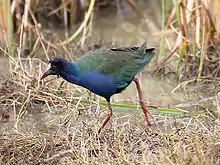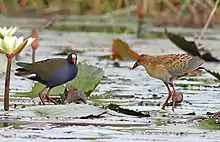Allen's gallinule
Allen's gallinule (Porphyrio alleni), formerly known as the lesser gallinule, is a small waterbird of the family Rallidae.
| Allen's gallinule | |
|---|---|
 | |
| Scientific classification | |
| Domain: | Eukaryota |
| Kingdom: | Animalia |
| Phylum: | Chordata |
| Clade: | Dinosauria |
| Class: | Aves |
| Order: | Gruiformes |
| Family: | Rallidae |
| Genus: | Porphyrio |
| Species: | P. alleni |
| Binomial name | |
| Porphyrio alleni | |
Taxonomy
Its former binomial name is Porphyrula alleni. Porphyrio is the Latin for "swamphen", and alleni, like the English name, commemorates British naval officer Rear-Admiral William Allen (1792–1864).[3][4]
Distribution and habitat
Its breeding habitat is marshes and lakes in Sub-Saharan Africa. Remarkably, this apparently weakly flying bird is not only the only species with a purely sub-Saharan African range to have reached Great Britain, but has done so twice. It has also occurred as a vagrant in several other European countries.
Description

They are similar in size to the only slightly larger water rail. The Allen's gallinule has a short red bill, greenish back and purple upperparts. They have red legs with long toes, and a short tail which is white with a dark central bar underneath. Breeding males have a blue frontal shield, which is green in the female. Immature Allen's gallinules are sandy brown with a buff undertail. The downy chicks are black, as with all rails. They nod their heads as they swim.
Breeding
Allen's gallinules are very secretive in the breeding season, particularly in the dense swamps they favour, and are mostly heard rather than seen. They are then rather noisy birds, with a sharp nasal pruk call. This species is partially migratory, undertaking seasonal movements. They can be easier to see on migration or when wintering. They build a floating nest in marshes and swamps, laying 2–5 eggs.
Diet
These birds probe with their bill in mud or shallow water, also picking up food by sight. They mainly eat insects and aquatic animals.
References
- BirdLife International (2016). "Porphyrio alleni". IUCN Red List of Threatened Species. 2016: e.T22692816A93370659. doi:10.2305/IUCN.UK.2016-3.RLTS.T22692816A93370659.en. Retrieved 11 November 2021.
- Thomson, T. R. H. (1842). "Description of a new species of Genetta, and of two species of Birds from Western Africa". The Annals and Magazine of Natural History, Including Zoology, Botany, and Geology. 10 (64): 203–205. doi:10.1080/03745484209445224.
- Beolens, Bo; Watkins, Michael (2003). Whose Bird? Men and Women Commemorated in the Common Names of Birds. London: Christopher Helm. p. 24.
- Jobling, James A (2010). The Helm Dictionary of Scientific Bird Names. London: Christopher Helm. pp. 42, 314. ISBN 978-1-4081-2501-4.
External links
- (Allen's gallinule = ) lesser gallinule - Species text in The Atlas of Southern African Birds
